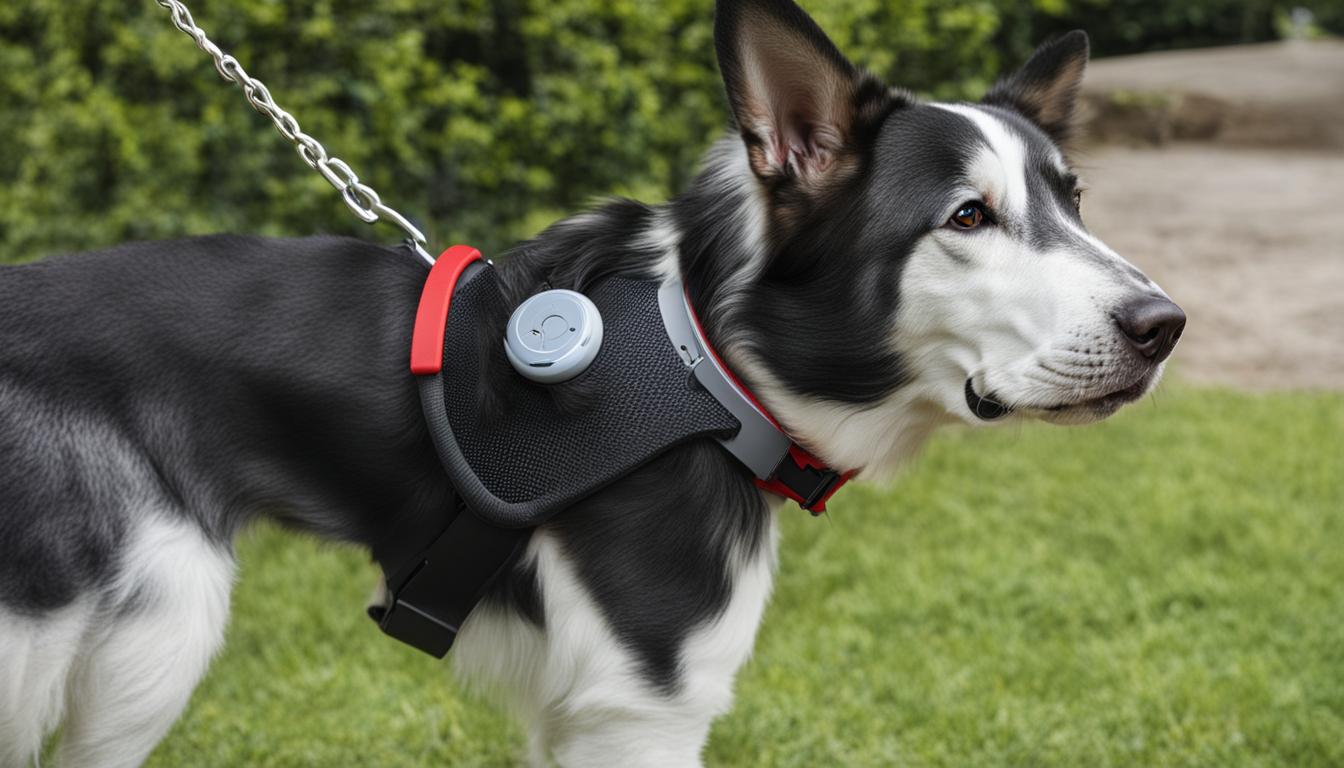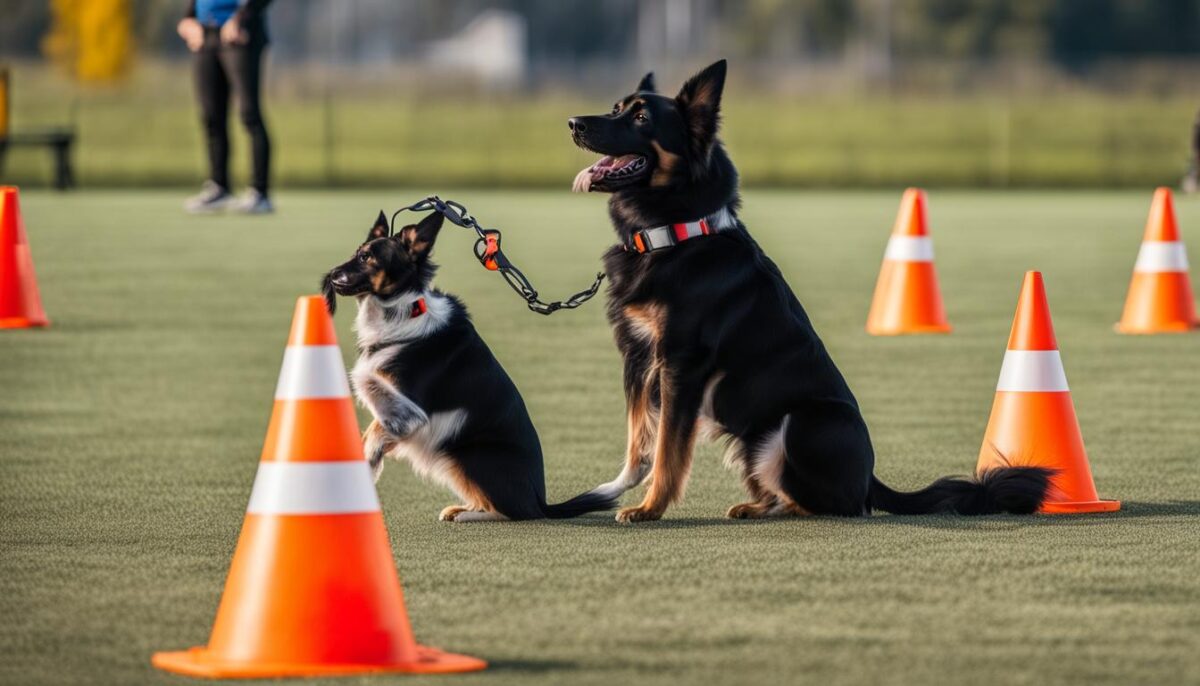Do you want your furry friend to listen better? Have you heard about e-collar training? Lots of people use a remote training collar to help their dogs learn right from wrong. Think of it like a little buzz that says, “Hey, pay attention!” to your pooch. These collars make a sound, shake a little, or give a tiny zap. They’re even good for dogs who can’t hear!
Before you start using one, your dog should be more than six months old. Make sure the collar fits just right: not too tight, but not too loose. You should have enough room to slip two fingers under the collar. And always start the zapping on the lowest level. You want to get your dog’s attention with the collar, not scare them. It’s all about teaching them with kindness.
Remember, you’re using the collar to teach dog obedience, not to be mean. It’s about making sure they know when they do something good. And if you do it right, both you and your best friend will be happier.
Key Takeaways
- Shock collars get your dog’s attention to teach them.
- Use sounds, vibrations or zaps to help your dog listen.
- Collars work even if your dog has trouble hearing.
- Fitting the collar right is super important.
- Always start with the lowest zap and go up only if you need to.
- Teach your dog with love, using the collar to help, not hurt.
Understanding Shock Collars and Their Benefits in Dog Training
Let’s talk about a tool that helps train dogs called a shock collar. It’s like a little helper that can make a beep, a buzz, or a small zap to teach dogs what’s okay and what’s not. It helps you tell your furry friend how to behave better and listen to your commands. Just like when you learn to raise your hand in class to speak, doggies can learn to sit or stay quiet with a little buzz from their collar.
What is a Shock Collar?
Imagine having a remote control that could help you train your dog. That’s what a shock collar is. It’s a collar that goes on your dog’s neck and helps them learn through sounds, vibrations, or a safe static shock when they do something they shouldn’t. It’s a popular way to make sure your dog listens and plays nice at the park or at home.
The Evolution of Shock Collars Over Time
A long time ago, only hunters used shock collars to train dogs to hunt. These days, they’re much nicer and can be used to teach all dogs right from wrong. They don’t hurt; they just help your doggy remember the rules, kind of like getting a gentle nudge when you forget to say “please” or “thank you.”
The Safety and Efficacy of Modern Shock Collars
Today’s shock collars are like superheroes that make sure your dog plays safe. They have different levels of beeps and buzzes, so it never hurts, just gets your dog’s attention. These smart collars are there to help you and your doggy have the best time playing and learning together!
Think of modern shock collars as little gadgets that make training your dog easier. They’re made to be very safe and only give a quick beep or buzz to help your dog remember what you’ve taught them. They’re not scary or mean; they’re just one of the tools you can use to teach your doggy how to behave.
| Old Collars | Modern Collars |
|---|---|
| Only static shock | Beep, vibration, and gentle static |
| Hard to adjust | Easy to adjust for safety |
| Used for hunting dogs | Great for all dogs |
Keep in mind, modern shock collars are not toys, and they’re not meant to be used all the time. They’re like a special tool that helps your dog be the best they can be. When used right, they make training fun and easy for both of you!
How to Train a Dog with a Shock Collar
Teaching your furry friend with a shock collar can sound scary, but don’t worry! It’s all about making sure they understand what’s good and what’s not. Let’s go step by step and learn how to use a shock collar to train your dog the right way.
Pre-Training Assessments and Preparations
Before you begin, check if your dog knows the basics like ‘sit’ and ‘come’. Just like you wouldn’t start learning to run before you can walk, your dog needs the basics down first! You’ll also want to ensure they’re comfy with signals, like the sound of a clicker. This helps with the shock collar preparations and boosts your dog training readiness.
Finding the Right Intensity for Your Dog
Every dog is different. So when adjusting their e-collar, start low. The goal is to find the level where your dog perks up but isn’t scared. This is called the “just right” level. It’s the sweet spot for dog training intensity levels where they notice the tap but don’t get anxious.
Reinforcing Basic Obedience Commands
Now onto the fun part! Use the e-collar to help your dog remember what they’ve already learned. Things like ‘sit’, ‘stay’, ‘come’, and ‘down’ are the basic dog commands. It’s like playing a game where the correct move gets them a little buzz as a reminder. And when they do it right, celebrate with treats and cuddles for obedience reinforcement!
Fostering Positive Behavior and Communication
Remember, the shock collar isn’t for scolding; it’s for chatting! Your goal is to talk to your dog with gentle taps. When they get it right, giving them snacks and pats tells them they’re on the right track. This builds a trusty bond and makes the whole process a positive dog training experience. Plus, good communication with shock collar can make you and your furry pal even closer!
And there you have it! With patience and care, you can use a shock collar to teach your dog how to behave. Just like any good chat, it’s all about understanding each other!
Conclusion
If you want your dog to listen and behave well, using a shock collar can be a good way to help teach them. This is called effective dog training. Shock collars can give little beeps, vibrations, or tiny shocks to help your dog understand what you want them to do. But remember, the collar should be just one part of teaching your dog good manners.
It’s really important to use the shock collar in a kind way. That means you need to be patient and use it to talk to your dog, not to be mean. Sometimes you might need a teacher to show you how to use it best. Not all dogs like the shock collar. Some dogs might do better with just the beeps or the shakes from the collar. If you use the collar in the right way, it can really help your dog learn. This is called successful e-collar use.
When you use the shock collar with other ways of teaching, like giving treats and love when your dog does the right thing, you can have a happy and good dog. The key is to be nice, take your time, and always keep learning the best ways to help your dog be their best.
FAQ
What are the basics of e-collar training for dog obedience?
E-collar training for dog obedience involves using a remote training collar to deliver stimuli such as tone, vibration, or shock to grab your dog’s attention and enforce good behaviors. It’s important to start with basic commands and use the e-collar to reinforce these behaviors in conjunction with positive reinforcement techniques.
What is a shock collar and how is it used in dog training?
A shock collar, also known as an electronic collar or e-collar, is a device that sends a static shock, vibration, or tone in response to a dog’s behavior. It’s used to address behavioral issues, enforce obedience commands, and can be particularly useful for training deaf dogs through vibration or tone.
How have shock collars evolved to ensure they are humane and effective?
Since their inception in the 1960s, shock collars have undergone significant improvements. They now provide adjustable levels of stimulation and offer additional corrective methods, such as vibrations and tones, making them more humane and effectively tailored to a dog’s sensitivity.
Are modern shock collars safe for all dogs?
Modern shock collars are safe and effective when properly fitted and used at the correct stimulation levels. It’s essential to ensure the collar is appropriate for your dog’s age, size, and temperament and to use the stimulations as communication aids rather than punishment.
How do you assess if your dog is ready for training with a shock collar?
Before starting shock collar training, make sure your dog understands basic obedience commands such as ‘sit’, ‘stay’, ‘come’, and ‘down’. Familiarity with markers, like clickers, can also help indicate your dog’s readiness. Observing your dog’s behavior when introducing the collar at the lowest stimulation level is crucial for assessing their response.
How do you find the right intensity setting on an e-collar for your dog?
Begin with the lowest intensity setting and incrementally increase until you see a subtle but noticeable behavior change, indicating that your dog is aware of the stimulation. The appropriate level should get your dog’s attention without causing distress or discomfort.
What role does positive reinforcement play when training with a shock collar?
Combining e-collar stimuli with positive reinforcement, like treats and praise, helps the dog associate the correction with good behavior. This not only makes the training process more enjoyable for your dog but also strengthens the bond between you and your dog and enhances the effectiveness of the training.
Can e-collars be used to train any dog breed?
While e-collars can be versatile tools for training many breeds, not every dog will respond well to this method. It’s essential to consider breed-specific traits, as well as the individual dog’s temperament and sensitivity, before deciding on using an e-collar. Alternative methods may be more suitable for some dogs.
Should a shock collar be used as the sole method of training a dog?
No, a shock collar should not be the sole training method. It’s most effective when used in combination with traditional training techniques, serving as an additional tool for reinforcing commands and correcting unwanted behaviors within a comprehensive training regime.
What should you do if your dog does not respond to the e-collar?
If your dog does not respond to the e-collar, you should reassess the fit and intensity level of the collar, consult with a professional dog trainer, and consider using other training methods. It’s important to remember that each dog is unique and may require different training approaches.

